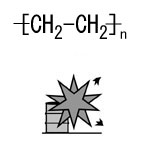| Case Name |
Explosion caused due to a high temperature from adiabatic compression during transferring high-pressure air at a polyethylene manufacturing plant |
| Pictograph |

|
| Date |
July 30, 1991 |
| Place |
Ichihara, Chiba, Japan |
| Location |
Chemical factory |
| Overview |
An airtight test was carried out with high-pressure air at a high-pressure polyethylene manufacturing plant. An explosion occurred from wax adhering to the piping at a high temperature when the air was transferred to another location for reuse, and adiabatic compression occurred in the piping. The explosion was caused by rapid pressurizing of the system with flammables in high-pressure air. Similar accidents are frequently reported in air compressors and oxygen piping. |
| Incident |
An airtight test was carried out with compressed air after a wax cooler was changed at a high-pressure polyethylene manufacturing plant. An explosion occurred in piping when compressed air was transferred to a wax separator for an airtight test. |
| Processing |
Manufacture |
| Individual Process |
Maintenance |
| Chemical Reaction |
Polymerization |
| Chemical Equation |
Fig2.Chemical reaction formula
|
| Substance |
Polyethylene, Fig3 |
| Type of Accident |
Explosion |
| Sequence |
The airtight test of a wax cooler was carried out at 16.2 MPa. Intermediate piping exploded when the pressure of the wax cooler reached 10 MPa during decompression by air drawing-off to the wax separator via intermediate piping |
| Cause |
In decompression operation, drawn-off air was compressed adiabatically at a narrow part of intermediate piping and it reached a high temperature. As a result, wax adhering to the inner piping ignited and exploded upon making contact with high-temperature and high-pressure air.
Pressured air from a large-capacity wax cooler did not smoothly pass through the thin piping, and adiabatic compression was caused in the piping. |
| Response |
Not applicable. |
| Countermeasures |
1. The airtight test using flammable gas was stopped.
2. Swift reporting is considered. |
| Knowledge Comment |
Accidents of compressed air occur occasionally. It is dangerous to use oxygen and air for an airtight test. |
| Background |
1. There was a breach of operating instructions. Instructions on decompression were given to use another piping.
2. Rapid decompression has danger of adiabatic compression depending on a decompression route and shapes. There was a lack of awareness of adiabatic compression heat of compressed air and strong inflammability of flammables in compressed air. |
| Incidental Discussion |
Why were operating instructions violated? It is considered that instructions were given without specifying the reason. It can be assumed that the work would be easier for workers if high-pressure air could be reused. Although the person giving instructions might have recognized the danger of adiabatic compression, whether he indicated it when giving the instruction is questionable. It is also not plausible to expect workers to have realized the possibility of adiabatic compression in this case, even if they knew the words. This indicates that instructions given without clear reasons might be ignored. |
| Reason for Adding to DB |
Example of explosion caused due to compressed air |
| Scenario |
| Primary Scenario
|
Poor Value Perception, Poor Safety Awareness, Inadequate Risk Recognition, Ignorance, Insufficient Knowledge, Insufficient Experience and Study, Planning and Design, Poor Planning, Poor Depressure Planning at Purge, Malicious Act, Rule Violation, Indication Violation, Bad Event, Thermo-Fluid Event, Heating by Local Compression Process, Secondary Damage, External Damage, Explosion, Bodily Harm, Injury, 2 person injured, Loss to Organization, Economic Loss, Manetary Damage 40 million yen
|
|
| Sources |
Fire and Disaster Management Agency, Explosion in piping of polyethylene production plant: Accident cases of dangerous materials. 1991, pp.264-266.
High Pressure Gas Safety Inst. of Japan. High-pressure gas protection overview. 1992 edition - pp.180-181(1992).
National dangerous object safety association. Explosion of wax adhering to piping wall in airtight test of polyethylene manufacturing plant. One hundred cases of accidents at dangerous facilities. -No.2- pp.92-93(1994)
|
| Number of Injuries |
2 |
| Physical Damage |
Fragments were scattered within a radius of 20 m of the site. High-pressure gas piping, valves, and lighting fittings were damaged. |
| Financial Cost |
¥ 40 million (Fire and Disaster Management Agency) |
| Multimedia Files |
Fig3.Chemical formula
|
| Field |
Chemicals and Plants
|
| Author |
WAKAKURA, Masahide (Kanagawa Industrial Technology Research Institute)
TAMURA, Masamitsu (Center for Risk Management and Safety Sciences, Yokohama National University)
|